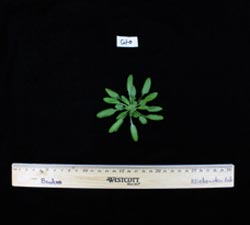Outside influence: Genes outside nucleus have disproportionate effect

Experiments with Arabidopsis plants like this six-week-old could help shape future IVF treatments. (Baohua Li, UC Davis. )<br>
Plant and animal cells carry most of their genes on chromosomes in the nucleus, separated from the rest of the cell. However, they also contain a small number of genes in organelles that lie outside the nucleus. These are the mitochondria, which generate energy for animal and plant cells, and chloroplasts, which carry out photosynthesis in plant cells.
The influence of genes outside the nucleus was known to an earlier generation of field ecologists and crop breeders, said Dan Kliebenstein, professor in the UC Davis Department of Plant Sciences and Genome Center and senior author on the paper published Oct. 8 in the online journal eLife. This is the first time that the effect has been quantified with a genomic approach, he said.
Bindu Joseph, a postdoctoral researcher in Kliebenstein's lab, and Kliebenstein studied how variation in 25,000 nuclear genes and 200 organellar genes affected the levels of thousands of individual chemicals, or metabolites, in leaf tissue from 316 individual Arabidopsis plants.
They found that 80 percent of the metabolites measured were directly affected by variation in the organellar genes — about the same proportion that were affected by variation among the much larger number of nuclear genes. There were also indirect effects, where organellar genes regulated the activity of nuclear genes that in turn affected metabolism.
“At first it's surprising, but at another level you almost expect it,” Kliebenstein said. “These organelles produce energy and sugar for cells, so they are very important.”
Similar effects could also occur in mammalian cells, Kliebenstein said. That has implications for in vitro fertilization therapies aimed at preventing diseases caused by faulty mitochondria being passed from mother to child. The British government recently proposed draft regulations for “three-parent embryos,” created by taking a the nucleus from a fertilized egg and putting it into an egg cell from a third donor with its own set of mitochondria. The technique has so far only been tested in animals.
“From what we can see in plants, there might be an issue, but it needs testing,” Kliebenstein said.
Large population surveys that aim to link conditions such as obesity to specific genes should also take more account of organellar genes, he said.
Co-authors on the paper are graduate student Jason Corwin and project scientists Baohua Li and Suzi Atwell. The work was supported by the National Science Foundation.
Media contact(s):
Daniel Kliebenstein, Plant Sciences, (530) 754-7775, kliebenstein@ucdavis.edu
Andy Fell, UC Davis News Service, (530) 752-4533, ahfell@ucdavis.edu
Media Contact
More Information:
http://www.ucdavis.eduAll latest news from the category: Life Sciences and Chemistry
Articles and reports from the Life Sciences and chemistry area deal with applied and basic research into modern biology, chemistry and human medicine.
Valuable information can be found on a range of life sciences fields including bacteriology, biochemistry, bionics, bioinformatics, biophysics, biotechnology, genetics, geobotany, human biology, marine biology, microbiology, molecular biology, cellular biology, zoology, bioinorganic chemistry, microchemistry and environmental chemistry.
Newest articles

“Nanostitches” enable lighter and tougher composite materials
In research that may lead to next-generation airplanes and spacecraft, MIT engineers used carbon nanotubes to prevent cracking in multilayered composites. To save on fuel and reduce aircraft emissions, engineers…

Trash to treasure
Researchers turn metal waste into catalyst for hydrogen. Scientists have found a way to transform metal waste into a highly efficient catalyst to make hydrogen from water, a discovery that…

Real-time detection of infectious disease viruses
… by searching for molecular fingerprinting. A research team consisting of Professor Kyoung-Duck Park and Taeyoung Moon and Huitae Joo, PhD candidates, from the Department of Physics at Pohang University…





















